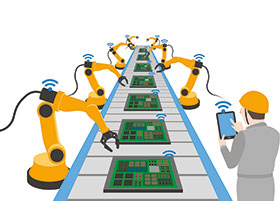

Image processing systems built around industrial cameras are already an essential component in automated production. Throughout all steps of manufacturing, from the inspection of raw materials and production monitoring (i.e. flaw detection) to final inspections and quality assurance, they are an indispensable part of achieving top efficiency and strict quality standards.
The term Industry 4.0 stands for new process forms and organisation within industrial production. The foundation for this comes through extensive networked data communication. The goal is self-organised, more strongly customised and efficient production based on extensive data collection and effective exchange of information.
Image recording and processing can be decisive elements for capturing the information required for Industry 4.0. What helps is that cameras continue to become smaller and more affordable, even as performance improves constantly. Where complex systems were once required, today‘s small, efficient systems can produce the same results, or better. This technological progress, taken together with the possibilities of ever-expanding networking, opens up the potential for new applications in Industry 4.0. This White Paper describes how image processing and industrial cameras can make manufacturing processes of the future a reality now.
How can machine vision systems and image processing make Industry 4.0 clothing production more efficient?
Modern garment sizes have been simplified and standardised to fit within four variants from S to XL. Low unit costs are achieved through high volume mass production.
Textile production using Industry 4.0 can instead deliver customised individual pieces by taking advantage of efficient data processing. Once a customer decides on a model, their dimensions can be measured via an image processing (machine vision) system. This might take the form of a small changing room with a camera in each wall to take a picture of each side of the body. Software handles the measurements and the subsequent cutting pattern for production. The remainder of production runs automatically right up through shipping. Fashion houses of the future will thus no longer sell their services based around full shelves with huge offerings, but rather through a large virtual selection and quick, reliable production.
New opportunities for small batches
The case study from the textile industry clearly illustrates one core principle of Industry 4.0: Automation of process controls allows for many workpieces to be produced cost effectively even in small batch production – a phenomenon known as ‘Batch Size 1’.
There are a variety of further examples in other fields as well. In particular, the possibilities are seemingly endless for industries where a high degree of customisation is required due to physical (biological), environmental or aesthetic (art, fashion) reasons. Yet how can precise industrial camera systems support in this effort?
Let us take as another example, the production of individual metal workpieces customised to the customer‘s needs, such as mailboxes or railings. The coating of metal parts is generally handled using automated spray nozzles following pre-programmed spray movements. Such movements are however difficult to plan in advance for custom work. While it is possible to calculate the patterns from the design specs, a calculation of that final spray pattern is highly complex and imprecise.
Industrial cameras, by contrast, can make precise measurements of the component on the spot, determining its individual shape and position and instructing the spray arms accordingly. At the same time, the painting results can also be controlled optically, either through assessment of the colouring or by measuring more complex reflective properties on the coating. This control data can flow in real time into the control unit. As such, a system for automated coating can become a self-learning system. New but similar components could then be processed more efficiently based on the prior experience.
Cameras as tireless process auditors
Sensor data can also help with early detection of changed or even flawed device behaviour, leading to automated countermeasures (such as changes to process parameters or ordering of replacement materials and/or service calls). This applies both to the production equipment as well as for the finished products. Industrial cameras play a significant role in this, as they offer a tireless method for auditing the colour, structural and geometric properties of even large workpieces and products for correctness or deviation. ‘Soft’ factors such as lubrication, wear and rusting can also be taken into account, providing data for a company‘s enterprise resource planning systems.
Image processing in production – robots and humans working hand in hand
Production employees will also benefit from applications using industrial cameras. Because, regardless of the progress of automation, there are good reasons why there will always be a place for humans in industrial production. These include human sensory capabilities, flexibility and affordability.
Even so, future workflows will also be changing as part of Industry 4.0. Human efficiency can be enhanced through intelligent image processing systems integrated into helmets, garments and tools. This is technically feasible as cameras continue to become smaller and lighter: high-precision industrial cameras of the size of stamps, weighing less than 30 g including lens and casing, are already available today. These vision systems record the activity and work status visually, audit results and identify reasonable follow-on steps or information. Subsequently they forward it to humans, for example as notifications on smart glasses working with augmented reality. The timely provision of working materials promotes a further increase of productivity.
Summary
Image processing will become a key element of Industry 4.0 and ensure:
New and more efficient business models through applications using image processing systems.
Automated, self-organised production based on extensive data collection and visually identified information.
More efficient production through extensive networking of vision systems in operational processes.
For more information contact Elton Murison, Esteq, +27 (0)12 809 9500, [email protected], www.esteq.co.za

© Technews Publishing (Pty) Ltd | All Rights Reserved